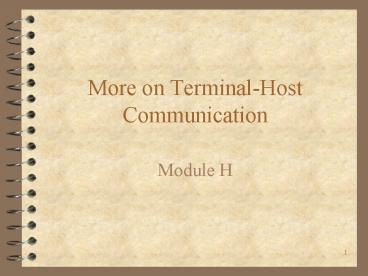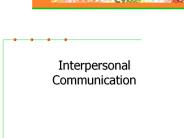More on TerminalHost Communication - PowerPoint PPT Presentation
1 / 52
Title:
More on TerminalHost Communication
Description:
Communications program. Dials the host and logs you in. Transfers files between PC and host ... Long-distance communication is expensive ... – PowerPoint PPT presentation
Number of Views:27
Avg rating:3.0/5.0
Title: More on TerminalHost Communication
1
More on Terminal-Host Communication
- Module H
2
Terminal-Host Systems
- Components
- Terminal
- Host (locus of processing)
- Transmission line
Host
Terminal
Transmission Line
3
Terminal Emulation
- People Already Have PCs
- Host operating systems only work with terminals
- Do not want to buy a terminal as well
- PCs can emulate (act like) terminals
Host
PC
Transmission Line
4
Locus of Processing
- Processing is Done on the Host
- Usually, poor response times
- Usually poor user interface (mostly text, simple
graphics if any)
Host
Terminal
Transmission Line
5
Legacy Systems
- Moving applications from hosts to other
platforms, especially client-server - Saves money
- Improves response times
Host
Terminal
Transmission Line
6
Legacy Systems
- However, moving applications is slow
- Many applications with large investments
- So in many firms, host legacy systems still run a
large share of all applications
Host
Terminal
Transmission Line
7
Matching Terminals and Hosts
- Designed as a Complete System
- Optimized for specific uses
- Cannot mix and match any terminal with any host
- Most hosts only work with a few terminals
Host
Terminal
8
VT100 Systems
- Use VT100 terminals
- Inexpensive
- Low-performance
- For light users
- Lowest common denominator supported by many hosts
VT100 Terminal
Supportive Host
9
IBM Mainframe Systems
- Designed to support hundreds of simultaneous
terminal users dispersed around the globe - Designed for heavy users, such as clerks, who
will use the system many hours per day and so
need fast response times and reliability - High performance, high cost
- Use SNA protocols instead of TCP/IP
10
IBM AS/400 Systems
- AS/400s are small business computers
- Minicomputers optimized for business transactions
- Widely used in industry
11
Windows Terminals
- Run Windows Programs
- Execution is done on a terminal server
- Results are shown on the WT screen
- Can run Windows applications
Windows Terminal Server
Windows Terminal
12
Network Computers (NCs)
- Often replace terminal-host systems
- But processing is done on network computer, so it
is not a true terminal - Low cost devices
- Programs downloaded from servers
- Limited to Java language programs
NC
Java
13
VT100 Terminal Systems
14
Basic Operation
- Each keystroke is sent to the host for processing
- Echoed back before shown on screen
- Dumb terminal
Host
VT100 Terminal
Keystroke
Echo
15
Basic Operation
- Each keystroke is sent to the host for processing
- Long delays if host is overloaded
- Places a heavy load on the host and network
Host
VT100 Terminal
Keystroke
Echo
16
VT100 Limitations
- Designed in the 1970s
- Simplicity allows it to be supported easily, so
widely supported - Poor user interface
- Text only
- Monospaced font
- Monochrome (text against contrasting background)
17
VT100 Limitations
- Slow Speed
- Uses serial ports
- 9-pin and 25-pin versions both work fine
- These ports were designed to work at less than 20
kbps - Although modern serial ports are faster, VT100s
still run at 9,600 bps or less
18
VT100 Limitations
- Limited to ASCII codes
- Designed for printed text in English
- 7 bits per byte
- Last bit in byte is for error detection
Symbol
ASCII
H
1001000
h
1101000
space
0100000
19
VT100 Limitations
- 8-Bit ASCII
- Used on PCs
- No eighth error checking bit
- All 8 bits represent data
20
Asynchronous Transmission
- Each character is placed in a frame by itself
- Each frame is sent separately
- There may be time wasted between frames
H
e
l
l
o
21
Asynchronous Transmission
- Each frame has ten bits
- For 8-bit ASCII start bit, stop bit, 8 data bits
Stop Bit (1)
Start Bit (0)
8 Data Bits
22
Asynchronous Transmission
- Idle line state is one (1111111111)
- Start bit (always 0) changes the line state to
signal the start of the frame - Stop bit (always 1) gives one time period of idle
so that next start bit can be read unambiguously
Start Bit (0)
Stop Bit (1)
8 Data Bits
23
Asynchronous Transmission
- Data bits sent in reverse order
- If 11110000,
- Sent as 00001111
- So if parity is even, send 0000011111
- Also reversed in 7-bit ASCII
Start Bit (0)
Stop Bit (1)
8 Data Bits (00001111)
24
Asynchronous Transmission
- For 7-Bit ASCII, still 10 bits per frame
- Start bit
- 7 data bits (remember that order of bits is
reversed) - parity bit
- Stop bit
Start Bit (0)
Stop Bit (1)
7 Data Bits
Parity Bit (1 or 0)
25
Parity
- For 7-bit ASCII Only (No Parity 8-bit ASCII)
- Transmit an 8th bit per character
- Even parity sum of data and parity bits is even
- To send 1110000 (odd), send 00001111
- Note that order of data bits is reversed
- To send 1111000 (even), send 00011110
- Odd parity sum is odd
- If error is detected, the character is simply
discarded
26
Asynchronous Transmission
- Another Look at 7-Bit ASCII Frames (direction
reversed)
4. Parity Bit
1. No Data State (1)
3. 7 Data Bits
7. Next Character
6. No Data State (1)
2. Start Bit (Always 0)
5 Stop Bit (Always 1)
27
Asynch Settings are Not Standardized
- Number of data bits/use of parity
- Number of stop bits
- Usually one but can be more for longer rests
between frames - Full versus half duplex
- Almost always full duplex today
- Speed (2,400 bps, 9600 bps, etc.)
- Setting up a VT terminal requires you to know
what the host requires for these parameter
28
VT100 Terminal Emulation
- Turn a 2,000 PC into a 200 VT100 Terminal
- Needed to be able to talk to some hosts
- Serial Ports are all the hardware you need
- Implement asynchronous ASCII transmission
29
VT100 Terminal Emulation
- Only Need Software
- Communications program
- Dials the host and logs you in
- Transfers files between PC and host
- Executes scripts (often-repeated series of
instructions)
30
Telnet
- Reach Host Through the Internet
- Need telnet program on PC and Host
- Log in as VT100 terminal user
Telnet Program
Telnet Program
Host
Internet
PC
31
Telnet
- Reach Host Through the Internet
- No setup needed (parity, etc.) this is all
standardized - Limited to the Internet
Telnet Program
Telnet Program
Host
Internet
PC
32
IBM Mainframe Communication
33
IBM Mainframe Communication
- Designed to Support ...
- Thousands of Terminals
- Scattered Across the World
- With high-performance computing
- With high reliability
34
Hardware Elements
- Mainframe Computer
- Very-high-speed machine for even the largest
applications - Optimized for business processing (disk and file
handling)
Mainframe
35
Hardware Elements
- IBM Mainframe Operating Systems
- MVS/CICS and MVS/IMS for transaction processing
- VM/CMS for decision support applications
Mainframe
36
Hardware Elements
- Terminal
- High-speed interface up to 2 Mbps
- Graphics (limited) and color
- Usually called 3270 terminals after early model
numbers
3270 Terminal
37
Hardware Elements
- 3270 Terminal Emulation
- Does not use asynchronous communication
- Uses EBCDIC instead of ASCII
- Requires kit consisting of expansion board and
software
PC Emulating 3270 Terminal
38
Support from PC Networks
- Synchronous Communication Gateway Server
- Acts as cluster controller
- Provides terminal emulation without hardware on
client PCs - Converts between TCP/IP or IPX/SPX and SNA
Communications Controller
Gateway
LAN
39
Hardware Elements
- Cluster Controller
- Manages several 3270 terminals and printers in an
office or remote site - Provides processing power for text editing
- Good response time for simple text editing tasks
- Reduces the load on the host and the network
Cluster Controller
40
Hardware Elements
- Communications Controller
- Manages cluster controllers
- Reduces the load on the mainframe
- Implements multiplexing with cluster controller
for multiple terminal-host connections to reduce
transmission costs
Multiplexing
Cluster Controller
41
IBM Mainframe Systems
- Response Time
- Fast terminals
- Fast mainframe
- Fast transmission lines
- Cluster controller editing to reduce some
response times - Rich User Interface
- Graphics
- Color
42
IBM Mainframe Computers
- Reduce the Load on the (Expensive) Mainframe
- Communications controller offloads communications
work - Cluster controllers local editing capability
offloads simple editing work - Mainframe can focus on the application(s)
43
IBM Mainframe Computers
- Reduce the Load on the Network
- Long-distance communication is expensive
- Multiplexing of lines between the cluster
controller and the mainframe reduces costs - Local editing via the cluster controller
eliminates communication associated with simple
text editing
44
Systems Network Architecture (SNA)
- IBM mainframes do not use TCP/IP
- They use Systems Network Architecture (SNA)
- Architecture designed for IBM mainframes
- Used by other mainframe vendors as well
- SNA traffic can dominate long-distance
communication costs
45
SNA Software
- On the mainframe, SSCP
- Systems Services Control Point
- To manage all connections between network
addressable units (later) - On the mainframe, VTAM
- Virtual Telecommunications Access Method
- On the communications controller, NCP
- Network Control Program
46
SNA NAUs
- Network Addressable Units (NAUs)
- Resources that can communicate with one another
- This requires an address
- User NAUs
- Human users
- Application programs
- Only application programs have addresses, but
users are still included in the picture
47
SNA NAUs
- Logical Unit (LU) NAUs
- LUs deal with users
- Terminals (LU 2) deal with users
- Mainframe connections to application programs (LU
6) - Note logical units can be hardware!
48
SNA NAUs
- Physical Unit (PU) NAUs
- Units that do not deal with users
- Cluster controllers (PU2)
- Communications controllers (PU4)
- VTAM (PU5)
- Note physical units can be software (VTAM)!
49
Role of SSCP
- System Services Control Point program
- Before two NAUs can communicate, SSCP must allow
it. - Central point of control very different from
TCP/IP, OSI - SSCP sets up a session
- Manages the communication during the session
- Breaks down the session
50
Layering
- Very different from OSI, TCP/IP and IPX/SPX
- Designed for terminal-host communication
- Master-slave focus, not peer-peer
- Real time interaction versus sending messages and
later getting responses
51
Layering
- End User
- Governs application program interactions
- Not really in SNA
- NAU Services
- Data formatting
- Program interfaces
- Data Flow Control
- Flow control within a session
52
Layering
- Transmission Control
- Controls sequence numbers for frames
- Path Control
- Similar to the OSI network layer
- Data Link Control
- Similar to the OSI data link layer
- Physical Layer
- Similar to the OSI physical layer































